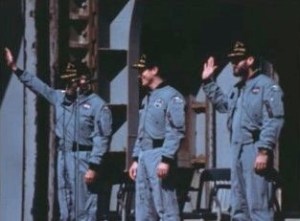55 Years Ago: President Nixon Establishes Space Task Group to Chart Post-Apollo Plans
In early 1969, the goal set by President John F. Kennedy to land a man on the Moon seemed within reach. A new president, Richard M. Nixon, now sat in the White House and needed to chart America’s course in space in the post-Apollo era. President Nixon directed his science advisor to evaluate proposals for […]
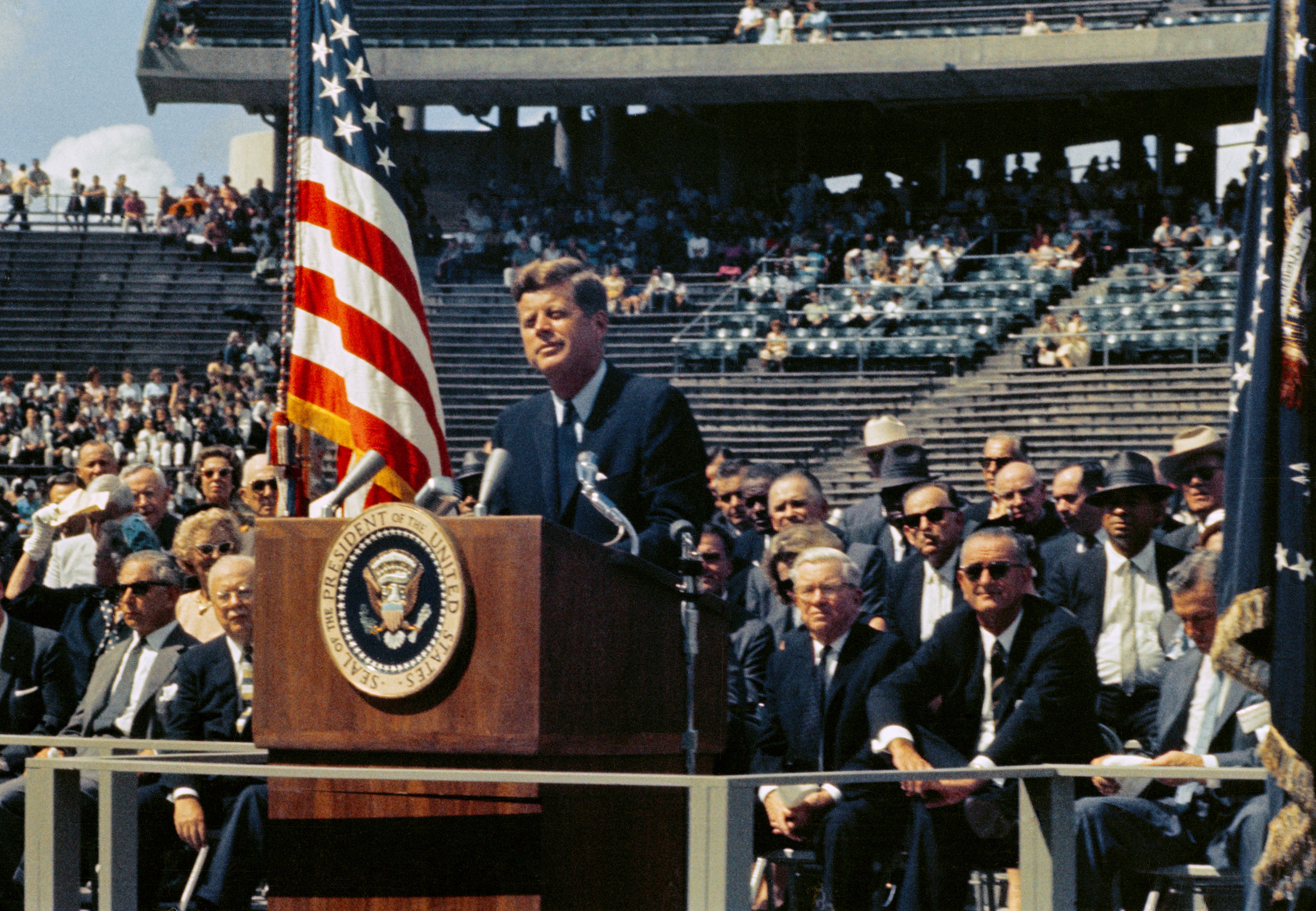
In early 1969, the goal set by President John F. Kennedy to land a man on the Moon seemed within reach. A new president, Richard M. Nixon, now sat in the White House and needed to chart America’s course in space in the post-Apollo era. President Nixon directed his science advisor to evaluate proposals for America’s next steps in space. He established a Space Task Group (STG), chaired by Vice President Spiro T. Agnew, to report back to him with their recommendations. The STG delivered its report to President Nixon on Sept. 15, 1969, who declined to select any of the options proposed. Instead, more than two years later, he directed NASA to build the space shuttle, just one element of the ambitious plans the STG had proposed.


Left: President John F. Kennedy announces his goal of a Moon landing during a Joint Session of Congress in May 1961. Right: President Kennedy reaffirms the goal during his address at Rice University in Houston in September 1962.
On May 25, 1961, President Kennedy, before a Joint Session of Congress, committed the United States to the goal, before the decade was out, of landing a man on the Moon and returning him safely to the Earth. President Kennedy reaffirmed the commitment during an address at Rice University in Houston in September 1962. Vice President Lyndon B. Johnson, who played a key role in establishing NASA in 1958, and under Kennedy served as the Chair of the National Aeronautics and Space Council, worked with members of Congress to ensure adequate funding for the next several years to provide NASA with the proper resources to meet that goal. Following Kennedy’s assassination in November 1963, now President Johnson continued his strong support of the space program to ensure that his predecessor’s goal of a Moon landing could be achieved within the stipulated time frame. But with increasing competition for scarce federal resources from the conflict in southeast Asia and from domestic programs, Johnson showed less interest in any space endeavors that might follow the Moon landing. The space agency’s annual budget peaked in 1966 and began a steady decline three years before Kennedy’s goal was met. From a budgetary standpoint, the prospects of a vibrant post-Apollo space program did not look too rosy, the Apollo triumphs of 1968 and 1969 notwithstanding.

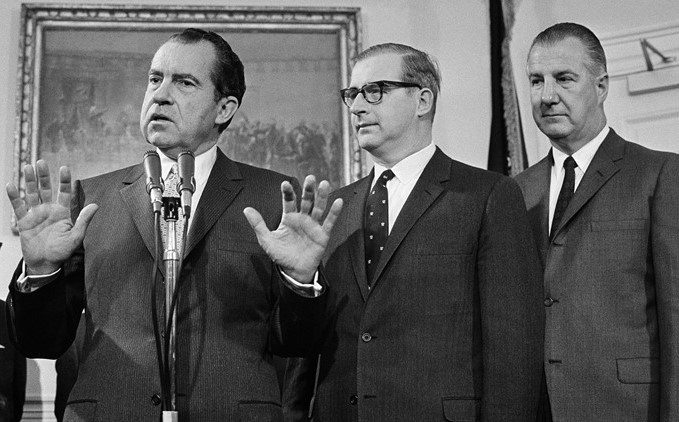
Left: President Richard M. Nixon, right, meets with his science advisor Lee DuBridge in the Oval Office – note the Apollo 8 Earthrise photo on the wall. Right: President Nixon, left, and Vice President Spiro T. Agnew, right, introduce Thomas O. Paine as the nominee to be NASA administrator on March 5, 1969.
On Feb. 4, just two weeks after taking office, President Nixon directed his Science Advisor Lee A. DuBridge to appoint an interagency committee to advise him on a post-Apollo space program. Nine days later, the President announced the formation of the STG to develop a strategy for America’s space program for the next decade. Vice President Agnew, as the Chair of the National Aeronautics and Space Council, led the group. Other members of the STG included NASA Acting Administrator Thomas O. Paine (the Senate confirmed him as administrator on March 20), the Secretary of Defense, and the Director of the Office of Science and Technology.
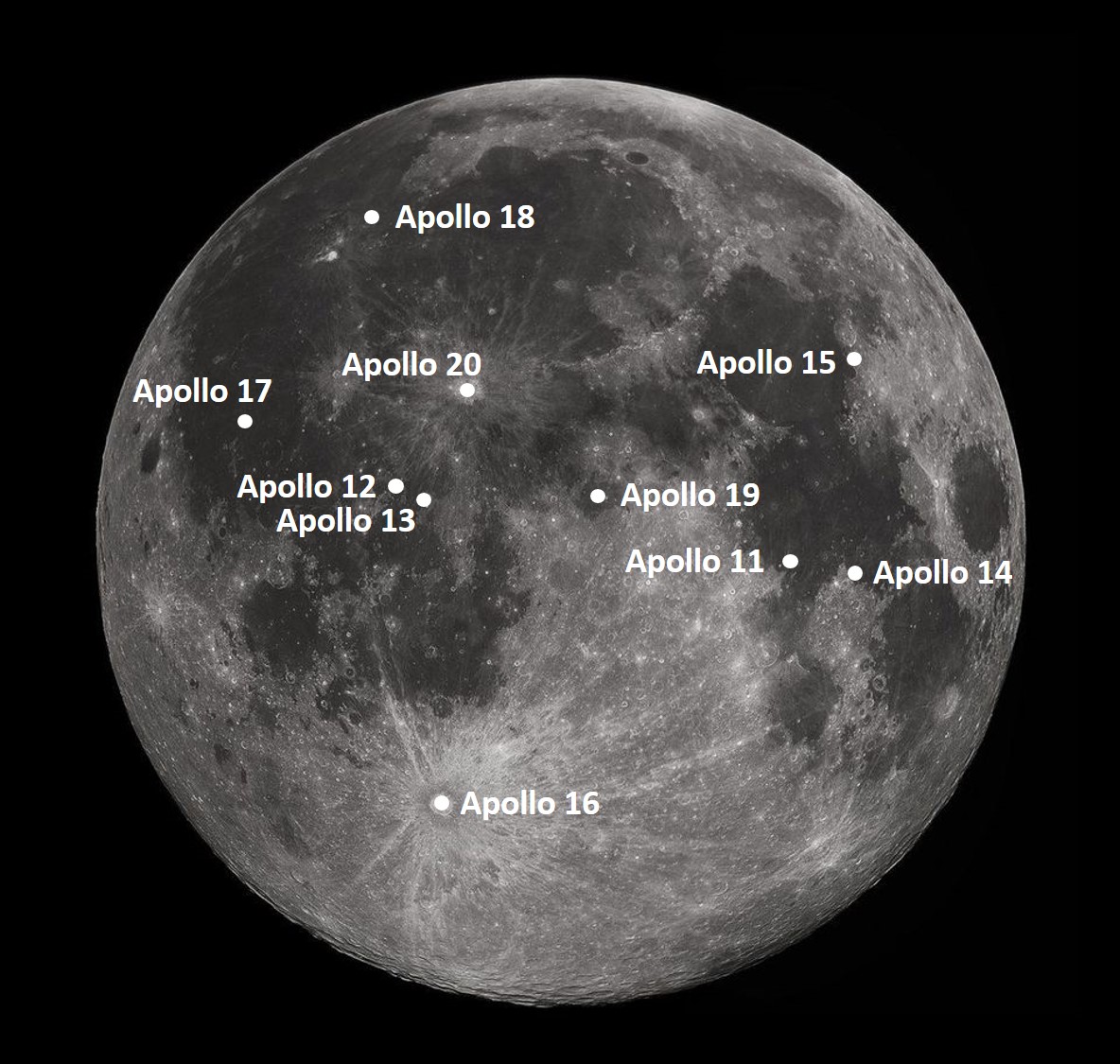

Left: Proposed lunar landing sites through Apollo 20, per NASA planning in August 1969. Right: Illustration of the Apollo Applications Program experimental space station.
At the time, the only approved human space flight programs included lunar missions through Apollo 20 and the Apollo Applications Program (AAP), later renamed Skylab, that involved three flights to an experimental space station based on Apollo technology. Beyond a general vague consensus that the United States human space flight program should continue, no approved projects existed to follow these missions when they ended by about 1975.

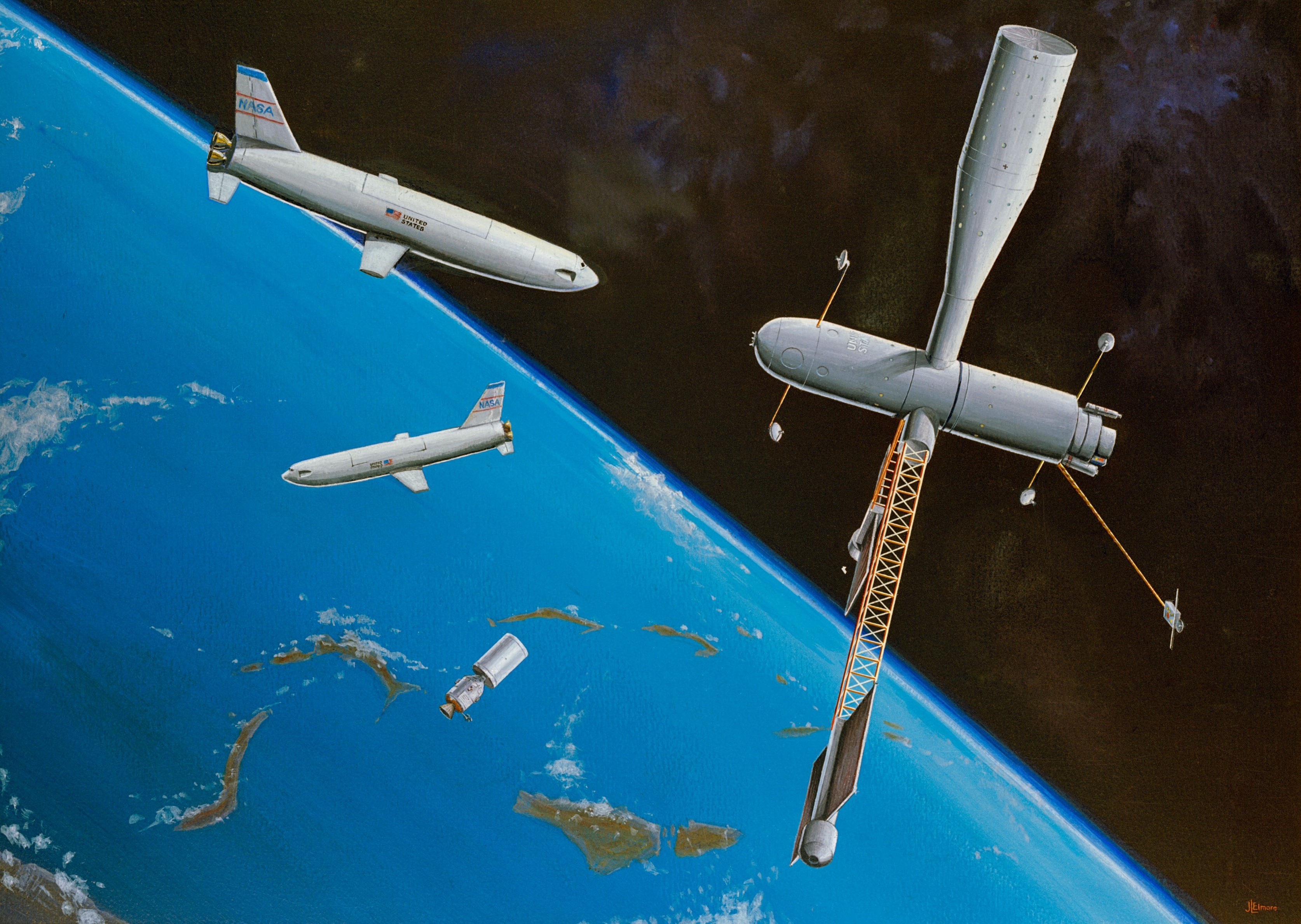

Left: Concept of a fully reusable space shuttle system from early 1969. Middle: Illustration from early 1969 of low Earth orbit infrastructure, including a large space station supported by space shuttles. Right: Cover page of NASA’s report to the interagency Space Task Group.
Within NASA, given the intense focus on achieving the Moon landing within President Kennedy’s time frame, officials paid less attention to what would follow the Apollo Program and AAP. During a Jan. 27, 1969 meeting at NASA chaired by Paine, a general consensus evolved that the next step after the Moon landing should involve the development of a 12-person earth-orbiting space station by 1975, followed by an even larger outpost capable of housing up to 100 people “with a multiplicity of capabilities.” In June, with the goal of the Moon landing about to be realized, NASA’s internal planning added the development of a space shuttle by 1977 to support the space station, and truly optimistically, the development of a lunar base by 1976, among other highly ambitious endeavors that included the idea that the U.S. should begin preparing for a human mission to Mars as early as the 1980s. These proposals were presented to the STG for consideration in early July in a report titled “America’s Next Decade in Space.”


Left: The Space Task Group’s (STG) Report to President Nixon. Right: Meeting in the White House to present the STG Report to President Nixon. Image credit: courtesy Richard Nixon Presidential Library and Museum.
Still bathing in the afterglow of the successful Moon landing, the STG presented its 29-page report “The Post-Apollo Space Program: Directions for the Future” to President Nixon on Sep. 15, 1969, during a meeting in the White House Cabinet Room. In its Conclusions and Recommendations section, the report noted that the United States should pursue a balanced robotic and human space program but emphasized the importance of the latter, with a long-term goal of a human mission to Mars before the end of the 20th century. The report proposed that NASA develop new systems and technologies that emphasized commonality, reusability, and economy in its future programs. To accomplish these overall objectives, the report presented three options:
Option I – this option required more than a doubling of NASA’s budget by 1980 to enable a human Mars mission in the 1980s, establishment of a lunar orbiting space station, a 50-person Earth orbiting space station, and a lunar base. A decision would be required by 1971 on development of an Earth-to-orbit transportation system to support the space station. A strong robotic scientific and exploration program would be maintained.
Option II – this option maintained NASA’s budget at then current levels for a few years then anticipated a gradual increase to support the parallel development of both an earth orbiting space station and an Earth-to-orbit transportation system, but deferred a Mars mission to about 1986. A strong robotic scientific and exploration program would be maintained, but smaller than in Option I.
Option III – essentially the same as Option II but deferred indefinitely the human Mars mission.
In separate letters, both Agnew and Paine recommended to President Nixon to choose Option II.


Left: Illustration of a possible space shuttle orbiter from 1969. Right: Illustration of a possible 12-person space station from 1969.
The White House released the report to the public at a press conference on Sep. 17 with Vice President Agnew and Administrator Paine in attendance. Although he publicly supported a strong human spaceflight program and enjoyed the positive press he received when photographed with Apollo astronauts, and initially sounding positive about the STG options, President Nixon ultimately chose not to act on the report’s recommendations. Faced with the still ongoing conflict in southeast Asia and domestic programs competing for scarce federal dollars, the fiscally conservative Nixon decided these plans were just too grandiose and far too expensive. He also believed that NASA should be considered as one America’s domestic programs without the special status it enjoyed during the 1960s, one of the lasting legacies of the Nixon space doctrine. Even some of the already planned remaining Moon landing missions fell victim to the budgetary axe. On Jan. 4, 1970, NASA canceled Apollo 20 since it needed its Saturn V rocket to launch the Skylab experimental space station – NASA Administrator James E. Webb had turned off the Saturn V assembly line in 1968 and none remained beyond the original 15 built under contract. In September 1970, reductions in NASA’s budget forced the cancellation of two more Apollo missions, and for a time in 1971 President Nixon considered cancelling two more but he relented, and they flew as the final two Apollo Moon landing missions in 1972.


Left: NASA Administrator James C. Fletcher, left, and President Richard M. Nixon announce the approval to proceed with space shuttle development in 1972. Right: First launch of the space shuttle in 1981.
More than two years after the STG submitted its report, in January 1972 President Nixon directed NASA Administrator James C. Fletcher to develop the Space Transportation System, the formal name for the space shuttle, the only element of the recommendations to survive the budgetary challenges. At that time, the first flight of the program was expected in 1979; in actuality, the first flight occurred two years later. It would be 12 years after Nixon’s shuttle decision before President Ronald W. Reagan approved the development of a space station, the second major component of the STG recommendation, and another 14 years after that before the first element of that program reached orbit. In those intervening years, the original American space station had been redesigned and evolved into the multinational partnership called the International Space Station.

The International Space Station as it appeared in 2021.
What's Your Reaction?





























